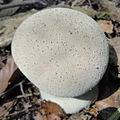Bag dusting
| Bag dusting | ||||||||||||
|---|---|---|---|---|---|---|---|---|---|---|---|---|

Pouch dusting ( Lycoperdon excipuliforme ) |
||||||||||||
| Systematics | ||||||||||||
|
||||||||||||
| Scientific name | ||||||||||||
| Lycoperdon excipuliforme | ||||||||||||
| ( Scopoli : Pers. ) Schaeff. |
The pouch or large dusting ( Lycoperdon excipuliforme , syn. Calvatia excipuliformis , Calvatia saccata , Handkea excipuliformis ) is a species of mushroom from the mushroom relatives . Trivial names with the word component “-bovist” are wrong, because Bovists do not have any fruiting bodies with a sterile stem area.
The fungus, which can be edible young, accumulates metals in its fruiting bodies and can make a significant contribution to the supply of iron, zinc and magnesium in the diet. For this, the right-penetrating small, easily flying through air movements spores by inhalation to the alveoli before and have allergenic potential.
features
Macroscopic features
The fruit bodies have a variable appearance. They usually have a pestle-shaped, more rarely pear-shaped habit and vary in width between 4 and 10 centimeters and in height between 7 and 12 (to 15) centimeters. They consist of a long, strong and sterile stem and a rounded, fertile head part. The spongy stem makes up half to three quarters of the height. The head part contains the fruit mass . In immature fruit bodies, it is white and cardboard, then yellow to olive green and pulpy, and finally it disintegrates into olive to purple-brown spore powder. The outer skin (exo peridia ) is initially gray-whitish, then cream to ocher and densely covered with fine, easily removable warmths. It stays light for a long time, then dries up, becomes light brown, parchment-like and tears open when the fruiting body is ripe. Young, white-fleshed specimens taste mild. While the ripe head part disintegrates into irregular pieces, the parchment-like, brown stem part, reminiscent of a cigar stump, survives the winter.
Microscopic features
The spherical, (olive) brown spores measure 4–6 micrometers, have a warty surface and a straight to slightly curved pedicelle up to 2.5 micrometers long . Four of the spores grow on the basidial cells . There are no cystids .
Species delimitation
The species is considered to be easily identifiable. The rabbit dusting ( Lycoperdon utriformis ) and the bottle dusting ( L. perlatum ) may be used for confusion . The hare puff is hardly stalked and discolored earlier.
Ecology, phenology and distribution
The bag dusting is a ground-dwelling saprobiont . It grows in forests (preferably deciduous forest) as well as on lawns and meadows.
The species fructifies from July to November.
It is widespread and quite common across Europe.
meaning
Young mushrooms are edible as long as the flesh is white. It is often cut into slices and breaded , otherwise cooked like fried potatoes.
Taxonomy
On the basis of newly published phylogenetic studies, it is classified in the genus of the pollen ( Lycoperdon ). The variable appearance of the fruiting bodies has resulted in a long list of synonymous (scientific) names. The official first description goes back to Giovanni Antonio Scopoli , who described the species in the second volume of the second edition of his work "Flora Carniolica" published in 1772.
swell
- ↑ Ellen Larsson, Mikael Jeppson: Phylogenetic relationships among species and genera of Lycoperdaceae based on ITS and LSU sequence data from north European taxa . In: Mycological Research . tape 112 , no. 1 , January 2008, p. 4-22 , doi : 10.1016 / j.mycres.2007.10.018 , PMID 18207380 (English).
- ↑ Carmen Cristina Elekes, Gabriela Busuioc: The Metal Concentrations and Daily Physiological Contribution of Mushrooms for the Necessary of Iron, Magnesium and Zinc . In: Bulletin UASVM Agriculture . tape 67 , no. 2 , 2010 (English).
- ↑ Carmen Cristina Elekes, Gabriela Busuioc: Heavy metals bioaccumulation in species of wild growing mushrooms . In: Lucrări ştiinţifice . tape 53 , no. 2 , 2010 (English).
- ↑ Marianne Geiser, Nicolas Leupin, Isabelle Maye, Vinzenz Im Hof, Peter Gehr: Interaction of fungal spores with the lungs: Distribution and retention of inhaled puffball ( Calvatia excipuliformis ) spores . In: Journal of Allergy and Clinical Immunology . tape 106 , no. 1 , July 2000, p. 92–100 , doi : 10.1067 / May 2000.107753 (English).
- ↑ Pilzlexikon ( Memento of the original from October 3, 2011 in the Internet Archive ) Info: The archive link has been inserted automatically and has not yet been checked. Please check the original and archive link according to the instructions and then remove this notice.
- ↑ Hans E. Laux: The great cosmos mushroom guide. All edible mushrooms with their poisonous doppelgangers. Franckh-Kosmos, Stuttgart 2001, ISBN 3-440-08457-4 , p. 610.
- ↑ Hans E. Laux: Edible mushrooms and their poisonous doppelgangers . Collect mushrooms - the right way. Kosmos Verlags-GmbH, Stuttgart 2005, ISBN 978-3-440-10240-4 , p. 91 .
- ↑ Markus Flück: Which mushroom is that? 3. Edition. Franckh-Kosmos Verlag, Stuttgart 2009, ISBN 978-3-440-11561-9 , pp. 353 .
- ^ Giovanni Antonio Scopoli: Flora Carniolica . exhibens plantas carnioliæ indigenas et distributas in classes, genera, species, varietates ordine linnaeano. tape 2 . Vienna 1772, p. 488 (Latin, archive.org ).





